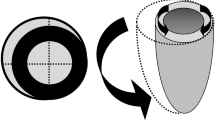Abstract
Right heart failure (RHF) is a life-threatening condition. Mechanical right heart support offers an option for critically ill patients. The PERKAT® RV device is designed for percutaneous implantation in acute RHF. It consists of a nitinol chamber covered by foils containing inflow valves. An outlet tube is attached to its distal tip. Using an 18F sheath, it is implanted in the inferior vena cava while the tube bypasses the right heart with its tip in the pulmonary trunk. Then, an IABP balloon is inserted in the pump chamber. Balloon deflation generates blood inflow into the chamber; during inflation, blood is pumped into the pulmonary arteries. The device is capable of achieving flow rates of up to 3.5 l/min under in vitro conditions. In vivo, we were able to increase cardiac output by 59% in a sheep model of acute pulmonary embolism. Based on this, our further research will focus on first-in-human implants.




Similar content being viewed by others
Abbreviations
- IABP:
-
Intra-aortic balloon pump
- LVAD:
-
Left ventricular assist device
- PERKAT RV:
-
Percutanous catheter technology right ventricular
- RVAD:
-
Right ventricular assist device
References
Ferrari, M. W. (2017). Future challenges in acute right heart failure. GSL Cardiovascular Diseases, 1, 102.
Harjola, V. P., Mebazaa, A., Čelutkienė, J., Bettex, D., Bueno, H., Chioncel, O., et al. (2016). Contemporary management of acute right ventricular failure: a statement from the Heart Failure Association and the Working Group on Pulmonary Circulation and Right Ventricular Function of the European Society of Cardiology. European Journal of Heart Failure, 18(3), 226–241.
Kapur, N. K., Paruchuri, V., Korabathina, R., Al-Mohammdi, R., Mudd, J. O., Prutkin, J., et al. (2011). Effects of a percutaneous mechanical circulatory support device for medically refractory right ventricular failure. The Journal of Heart and Lung Transplantation, 30(12), 1360–1367.
Wang, S., Izer, J. M., Clark, J. B., Patel, S., Pauliks, L., Kunselman, A. R., et al. (2015). In Vivo hemodynamic performance evaluation of novel electrocardiogram-synchronized pulsatile and nonpulsatile extracorporeal life support systems in an adult swine model. Artificial Organs, 39, E90–E101.
Maggioni, A. P., Dahlström, U., Filippatos, G., Chioncel, O., Leiro, M. C., Drozdz, J., et al. (2010). Heart Failure Association of ESC (HFA). EURObservational research programme: the Heart Failure Pilot Survey (ESC-HF Pilot). European Journal of Heart Failure, 12, 1076–1084.
Spinar, J., Parenica, J., Vitovec, J., Widimsky, P., Linhart, A., Fedorco, M., et al. (2011). Baseline characteristics and hospital mortality in the Acute Heart Failure Database (AHEAD) Main registry. Critical Care, 15, R291.
Kretzschmar, D., Lauten, A., & Ferrari, M. W. (2015). In vitro evaluation of a novel pulsatile right heart assist device—the PERKAT system. The International Journal of Artificial Organs, 38(10), 537–541.
Kretzschmar, D., Schulze, P. C., & Ferrari, M. W. (2017). Hemodynamic performance of a novel right ventricular assist device (PERKAT). ASAIO Journal, 63(2), 123–127.
Anastasioua, A. D., Spyrogiannia, A. S., Koskinasb, K. C., Giannogloub, G. D., & Parasa, S. V. (2012). Experimental investigation of the flow of a blood analogue fluid in a replica of a bifurcated small artery. Medical Engineering & Physics, 34, 211–218.
Brookshier, K. A., & Tarbell, J. M. (1993). Evaluation of a transparent blood analog fluid: aqueous xanthan gum/glycerin. Biorheology, 30, 107–116.
Kretzschmar, D., Lauten, A., Schubert, H., Bischoff, S., Schulze, C., & Ferrari, M. W. (2018). PERKAT RV: first in vivo data of a novel right heart assist device. EuroIntervention, 13(18), e2116–e2121.
Santamore WP, Gray LA Jr. (1996). Left ventricular contributions to right ventricular systolic function during LVAD support. The Annals of Thoracic Surgery, 61(1):350–356.
Hochman, J. S., Buller, C. E., Sleeper, L. A., Boland, J., Dzavik, V., Sanborn, T. A., et al. (2000). Cardiogenic shock complicating acute myocardial infarction—etiologies, management and outcome: a report from the SHOCK Trial Registry. Should we emergently revascularize occluded coronaries for cardiogenic shock? Journal of the American College of Cardiology, 36(3 Suppl A), 1063–1070.
Thiele, H., Zeymer, U., Neumann, F. J., Ferenc, M., Olbrich, H. G., Hausleiter, J., et al. (2013). Intra-aortic balloon counterpulsation in acute myocardial infarction complicated by cardiogenic shock (IABP-SHOCK II): final 12 month results of a randomised, open-label trial. Lancet, 382(9905), 1638–1645.
Acknowledgements
The PERKAT RV device was developed and designed in cooperation with Novapump GmbH (Jena, Germany). We thank Ronald Reich, Joerg Pfeifer, Patrick Patzer, and Yu-Jin Heinekamp. The team from Novapump has significantly contributed to the development and testing of PERKAT RV and has been working closely with the authors to implement the suggestions for improved handling of the device.
Funding
This study was supported by the German Ministry of Education and Research (BMBF-PERKAT-13GW0013C).
Author information
Authors and Affiliations
Corresponding author
Ethics declarations
Conflict of Interest
Prof. Dr. Dr. M. W. Ferrari is cofounder and shareholder of Novapump. For the remaining authors, no conflicts of interest were declared.
Ethical Approval
All applicable international, national, and institutional guidelines for the care and use of laboratory animals were followed and approved by the appropriate institutional committees. Permission for the animal experiments was obtained from the Governmental Commission for Animal Protection, Free State of Thuringia, Germany (registration number: 02-048/14).
Informed Consent
This article does not contain any studies with human participants performed by any of the authors.
Additional information
Associate Editor Navin Kumar Kapur oversaw the review of this article.
Rights and permissions
About this article
Cite this article
Kretzschmar, D., Schulze, P.C. & Ferrari, M.W. Concept, Evaluation, and Future Perspectives of PERKAT® RV—A Novel Right Ventricular Assist Device. J. of Cardiovasc. Trans. Res. 12, 150–154 (2019). https://doi.org/10.1007/s12265-018-9834-9
Received:
Accepted:
Published:
Issue Date:
DOI: https://doi.org/10.1007/s12265-018-9834-9




